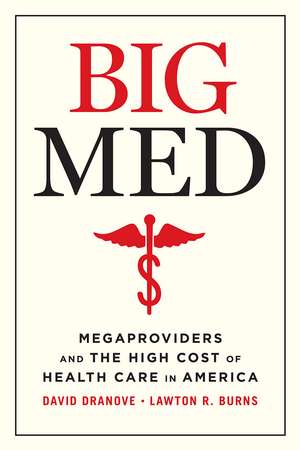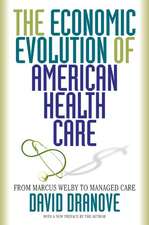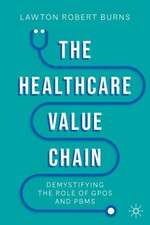Big Med: Megaproviders and the High Cost of Health Care in America
Autor David Dranove, Lawton Robert Burnsen Limba Engleză Hardback – 25 mai 2021
Drawing on decades of combined expertise in health care consolidation, Dranove and Burns trace Big Med’s emergence in the 1990s, followed by its swift rise amid false promises of scale economies and organizational collaboration. In the decades since, megaproviders have gobbled up market share and turned independent physicians into salaried employees of big bureaucracies, while delivering on none of their early promises. For patients this means higher costs and lesser care. Meanwhile, physicians report increasingly low morale, making it all but impossible for most systems to implement meaningful reforms.
In Big Med, Dranove and Burns combine their respective skills in economics and management to provide a nuanced explanation of how the provision of health care has been corrupted and submerged under consolidation. They offer practical recommendations for improving competition policies that would reform megaproviders to actually achieve the efficiencies and quality improvements they have long promised.
This is an essential read for understanding the current state of the health care system in America—and the steps urgently needed to create an environment of better care for all of us.
| Toate formatele și edițiile | Preț | Express |
|---|---|---|
| Paperback (1) | 136.71 lei 22-36 zile | +25.95 lei 5-11 zile |
| University of Chicago Press – 10 noi 2022 | 136.71 lei 22-36 zile | +25.95 lei 5-11 zile |
| Hardback (1) | 284.22 lei 22-36 zile | |
| University of Chicago Press – 25 mai 2021 | 284.22 lei 22-36 zile |
Preț: 284.22 lei
Nou
Puncte Express: 426
Preț estimativ în valută:
54.40€ • 59.11$ • 45.73£
54.40€ • 59.11$ • 45.73£
Carte disponibilă
Livrare economică 31 martie-14 aprilie
Preluare comenzi: 021 569.72.76
Specificații
ISBN-13: 9780226668079
ISBN-10: 022666807X
Pagini: 336
Ilustrații: 2 figures, 3 tables
Dimensiuni: 152 x 229 x 33 mm
Greutate: 0.61 kg
Ediția:First Edition
Editura: University of Chicago Press
Colecția University of Chicago Press
ISBN-10: 022666807X
Pagini: 336
Ilustrații: 2 figures, 3 tables
Dimensiuni: 152 x 229 x 33 mm
Greutate: 0.61 kg
Ediția:First Edition
Editura: University of Chicago Press
Colecția University of Chicago Press
Notă biografică
David Dranove is the Walter McNerney Distinguished Professor of Health Industry Management at Northwestern University's Kellogg Graduate School of Management, where he is also professor of strategy and faculty director of the Kellogg PhD program. Lawton Robert Burns is the James Joo-Jin Kim Professor at the Wharton School, University of Pennsylvania, where he is also professor of healthcare management, professor of management, and codirector of the Roy and Diana Vagelos Program in Life Sciences and Management.
Extras
In the spring of 2018, Northwestern Medicine opened its new hospital campus in the leafy Chicago suburb of Lake Forest. The $400 million dollar complex is the latest addition to Northwestern Memorial HealthCare’s impressive system. The sprawling main campus, which sits immediately east of luxury shopping on Chicago’s famed Michigan Avenue, includes the recently constructed $280 million Prentice Women’s Hospital and $600 million Lurie Children’s Hospital. The nearby flagship Northwestern Memorial Hospital has undergone more than $1 billion in expansions and renovations. Northwestern’s four thousand physicians, including fifteen hundred who are employed by the system, practice at more than two hundred facilities throughout Chicagoland, delivering the whole gamut of patient services, from basic primary care to the most technologically advanced diagnostic and surgical procedures. Northwestern also seems to have converted any number of defunct Borders, Office Depots, and Linens and Things into freestanding medical office buildings.
This enormous medical care provider is also a big business. Northwestern is Chicago’s sixteenth largest employer and, with annual revenues of around $5 billion, it brings in as much money as many wellknown global businesses, such as Goldman Sachs and Tiffany, and about the same as Fox News, CNN, and MSNBC combined! Northwestern is not even the largest health system in the Chicago metro area. That honor belongs to Advocate Health, whose annual revenues exceed $6 billion. Northshore University Health, the University of Chicago, and Loyola Medicine are not that far behind. As big as they currently are, they continuously plow their revenues into further growth, spreading their tentacles further and further across the Chicago metropolitan area.
Chicago is far from unique. Nearly every metropolitan area has its own giant health care systems; we call them megaproviders. Table I.1 gives annual revenues for some of the top local megaproviders, and identifies national and global companies in other industries that have similar revenues. Baylor, Scott, and White, which dominates the Dallas health care landscape, does as much business as Chipotle worldwide. Northwell, which dominates Long Island, is as big as Adobe Systems. The University of Pittsburgh Medical Center, which has a near stranglehold on Pittsburgh and much of the rest of western Pennsylvania, is as big as Whole Foods. These megaproviders are so large because the overall health care industry is enormous. With total US health care spending approaching $4 trillion, equivalent to roughly 18 percent of gross domestic product, even a locally based health care organization can be as big as giants in other industries.
These are just the tip of the iceberg. Other megaproviders include Fairview Health Services (eleven hospitals in the Twin Cities), Emory Healthcare (ten hospitals in the Atlanta metro area), BJC Healthcare (nine hospitals in and around St. Louis) and Jefferson-Einstein (eighteen hospitals in the Philadelphia area). Some systems span several local markets, with dominant positions in some places if not everywhere. Adventist-Providence St. Joseph operates nine hospitals across northern California; ProMedica has thirteen hospitals in Ohio and Michigan; Greenville-Palmetto owns thirteen hospitals across South Carolina; Wellmount-Mountain States operates twenty-one hospitals in Tennessee and Virginia; and Atrium Health runs forty-eight hospitals in the Carolinas and Georgia. All megaprovider systems own several hospitals, employ or ally with thousands of physicians, and have countless freestanding outpatient facilities and long-term care beds. A few offer their own health insurance products.
With mega-sized revenues comes mega-sized executive compensation. In 2017, at least fifty executives at nonprofit systems earned more than $4 million.4 At the top end, seven executives earned more than $8 million, with Inova’s CEO bringing home $14 million, topped only by the $16 million that Kaiser paid to its CEO. These figures may seem excessive, but they are in line with how other big businesses pay their executives. If we equate size with success, then health system CEOs have earned every penny. If we instead demand that our CEOs contain costs, then some would be lucky to make the minimum wage.
As health spending spirals out of control, putting health care beyond the reach of many Americans and eating into the savings of many more, it is no wonder that a large majority of Americans believe that the US health care system is broken. According to a recent Leavitt survey, 70 percent of respondents believe that the system requires fundamental changes or even a complete rebuild. Most Americans blame insurers, drug makers, and the government for the current predicament, and it is no surprise that drug makers compete with health insurers for most frequently being described as “rapacious.” Very few Americans—no more than 5 percent in the Leavitt survey—blame hospitals or doctors. Likewise, politicians are quick to blame insurers and drug makers—some prominent Democrats refuse to accept contributions from them—but they rarely blame hospitals and physicians, and eagerly accept their big dollar contributions. The blame is misplaced. Neither insurers nor the government order tests, write prescriptions, or perform surgeries. While many drugs are expensive to the point of seeming exorbitant, prescription drug spending accounts for less than 11 percent of total health spending. You could eliminate all administrative costs, wipe out insurance and drug industry profits, and slash their executives’ salaries, and health care would still be incredibly expensive.
As much as we complain about insurers, drug companies, and government bureaucrats, it is our health care providers who are largely responsible for the cost and quality of care. About 52 percent of every dollar spent on health care goes directly to hospitals and doctors. Even this understates their importance. Doctors make decisions that affect roughly 80 to 85 percent of every dollar spent. The most expensive medical technology is not drugs or magnetic resonance imaging (MRI); it is the physician’s pen.
Megaproviders like those listed in table I.1 assume the biggest responsibility for the state of our health system. They generate the lion’s share of expenses, and their executives are handsomely rewarded. Yet Americans are unwilling to take them to task. This might be understandable if megaproviders were slowing the pace of spending growth, but the facts that we will lay out suggest just the opposite. A recently published study by Zack Cooper and colleagues offers one compelling piece of evidence. The title of the paper hints at the findings: “The Price Ain’t Right? Hospital Prices and Health Spending on the Privately Insured.” Cooper et al. explain why health spending varies so much from one place to another, even after controlling for local differences in the medical needs of patients. They find that fully half of the variation stems from variation in provider prices. Prices are higher where hospitals have more market power, and prices increase when hospitals merge, especially when those hospitals are nearby and are likely to have been close competitors. This latter finding bears on an important theme of this book: health care is local, and megaproviders have a great deal of power in their local markets.
“The Price Ain’t Right” is just one of many studies documenting how megaproviders accumulate market power and use that power to drive up prices without creating offsetting efficiencies. Other studies find no improvements in patient outcomes; if anything, megaproviders contribute to lower-quality care. This means that wherever megaproviders dominate local markets, health care spending is higher, often much higher, and health care quality is no better, and sometimes lower. This is a big win for megaproviders, and a big loss for everyone else. If this is not bad enough, rather than engaging physicians in the process of reforming healthcare, megaproviders have caused them to become increasingly disaffected, disgruntled, and distrusting, making it harder to effect meaningful improvements in costs and outcomes. While the executives who put the megaproviders together may not have intended to cause such damage, they have failed to turn their size to our advantage. It is time that we recognize the megaproviders for the megaproblems they are.
This enormous medical care provider is also a big business. Northwestern is Chicago’s sixteenth largest employer and, with annual revenues of around $5 billion, it brings in as much money as many wellknown global businesses, such as Goldman Sachs and Tiffany, and about the same as Fox News, CNN, and MSNBC combined! Northwestern is not even the largest health system in the Chicago metro area. That honor belongs to Advocate Health, whose annual revenues exceed $6 billion. Northshore University Health, the University of Chicago, and Loyola Medicine are not that far behind. As big as they currently are, they continuously plow their revenues into further growth, spreading their tentacles further and further across the Chicago metropolitan area.
Chicago is far from unique. Nearly every metropolitan area has its own giant health care systems; we call them megaproviders. Table I.1 gives annual revenues for some of the top local megaproviders, and identifies national and global companies in other industries that have similar revenues. Baylor, Scott, and White, which dominates the Dallas health care landscape, does as much business as Chipotle worldwide. Northwell, which dominates Long Island, is as big as Adobe Systems. The University of Pittsburgh Medical Center, which has a near stranglehold on Pittsburgh and much of the rest of western Pennsylvania, is as big as Whole Foods. These megaproviders are so large because the overall health care industry is enormous. With total US health care spending approaching $4 trillion, equivalent to roughly 18 percent of gross domestic product, even a locally based health care organization can be as big as giants in other industries.
These are just the tip of the iceberg. Other megaproviders include Fairview Health Services (eleven hospitals in the Twin Cities), Emory Healthcare (ten hospitals in the Atlanta metro area), BJC Healthcare (nine hospitals in and around St. Louis) and Jefferson-Einstein (eighteen hospitals in the Philadelphia area). Some systems span several local markets, with dominant positions in some places if not everywhere. Adventist-Providence St. Joseph operates nine hospitals across northern California; ProMedica has thirteen hospitals in Ohio and Michigan; Greenville-Palmetto owns thirteen hospitals across South Carolina; Wellmount-Mountain States operates twenty-one hospitals in Tennessee and Virginia; and Atrium Health runs forty-eight hospitals in the Carolinas and Georgia. All megaprovider systems own several hospitals, employ or ally with thousands of physicians, and have countless freestanding outpatient facilities and long-term care beds. A few offer their own health insurance products.
With mega-sized revenues comes mega-sized executive compensation. In 2017, at least fifty executives at nonprofit systems earned more than $4 million.4 At the top end, seven executives earned more than $8 million, with Inova’s CEO bringing home $14 million, topped only by the $16 million that Kaiser paid to its CEO. These figures may seem excessive, but they are in line with how other big businesses pay their executives. If we equate size with success, then health system CEOs have earned every penny. If we instead demand that our CEOs contain costs, then some would be lucky to make the minimum wage.
Teflon Coated Providers
As health spending spirals out of control, putting health care beyond the reach of many Americans and eating into the savings of many more, it is no wonder that a large majority of Americans believe that the US health care system is broken. According to a recent Leavitt survey, 70 percent of respondents believe that the system requires fundamental changes or even a complete rebuild. Most Americans blame insurers, drug makers, and the government for the current predicament, and it is no surprise that drug makers compete with health insurers for most frequently being described as “rapacious.” Very few Americans—no more than 5 percent in the Leavitt survey—blame hospitals or doctors. Likewise, politicians are quick to blame insurers and drug makers—some prominent Democrats refuse to accept contributions from them—but they rarely blame hospitals and physicians, and eagerly accept their big dollar contributions. The blame is misplaced. Neither insurers nor the government order tests, write prescriptions, or perform surgeries. While many drugs are expensive to the point of seeming exorbitant, prescription drug spending accounts for less than 11 percent of total health spending. You could eliminate all administrative costs, wipe out insurance and drug industry profits, and slash their executives’ salaries, and health care would still be incredibly expensive.
As much as we complain about insurers, drug companies, and government bureaucrats, it is our health care providers who are largely responsible for the cost and quality of care. About 52 percent of every dollar spent on health care goes directly to hospitals and doctors. Even this understates their importance. Doctors make decisions that affect roughly 80 to 85 percent of every dollar spent. The most expensive medical technology is not drugs or magnetic resonance imaging (MRI); it is the physician’s pen.
Megaproviders like those listed in table I.1 assume the biggest responsibility for the state of our health system. They generate the lion’s share of expenses, and their executives are handsomely rewarded. Yet Americans are unwilling to take them to task. This might be understandable if megaproviders were slowing the pace of spending growth, but the facts that we will lay out suggest just the opposite. A recently published study by Zack Cooper and colleagues offers one compelling piece of evidence. The title of the paper hints at the findings: “The Price Ain’t Right? Hospital Prices and Health Spending on the Privately Insured.” Cooper et al. explain why health spending varies so much from one place to another, even after controlling for local differences in the medical needs of patients. They find that fully half of the variation stems from variation in provider prices. Prices are higher where hospitals have more market power, and prices increase when hospitals merge, especially when those hospitals are nearby and are likely to have been close competitors. This latter finding bears on an important theme of this book: health care is local, and megaproviders have a great deal of power in their local markets.
“The Price Ain’t Right” is just one of many studies documenting how megaproviders accumulate market power and use that power to drive up prices without creating offsetting efficiencies. Other studies find no improvements in patient outcomes; if anything, megaproviders contribute to lower-quality care. This means that wherever megaproviders dominate local markets, health care spending is higher, often much higher, and health care quality is no better, and sometimes lower. This is a big win for megaproviders, and a big loss for everyone else. If this is not bad enough, rather than engaging physicians in the process of reforming healthcare, megaproviders have caused them to become increasingly disaffected, disgruntled, and distrusting, making it harder to effect meaningful improvements in costs and outcomes. While the executives who put the megaproviders together may not have intended to cause such damage, they have failed to turn their size to our advantage. It is time that we recognize the megaproviders for the megaproblems they are.
Recenzii
“David Dranove and Lawton R. Burns offer an exhaustive . . . analysis of the consolidation of US hospitals and the effect it has had on both the cost and quality of health care. . . . As the country tries to rein in the cost of health care, Big Med offers a forceful argument for focusing our attention on hospitals.”
"David Dranove and Lawton Burn’s new collaboration Big Med: Megaproviders and the High Cost of Health Care in America provides readers with a comprehensive tutorial on consolidation in United States healthcare markets over the past 40 years. . . . anyone with a serious interest in the prices of U.S. healthcare will want to have this rigorous and timely treatment on their bookshelf."
“For years, allies of big medicine have argued that Bigger is Better. Dranove and Burns take on that argument and show it is not true. They point out how big medicine is failing and how it can be reformed. This book is wonderfully informed and thoughtfully presented.”
“Incorporating tough-minded analysis with powerful rhetoric, this book describes why the US healthcare delivery system fails us, why mergers are unlikely to help, and what industry and policy leaders can do to turn things around.”
“Big Med is an absolute treasure trove of health care antitrust history, offering an important overview of the last two decades of the US health care industry through a competition lens. Its findings will appeal to health systems leaders and health economists alike.”
"The book is highly readable, even punctuated with pleasant moments of dry wit... The book also has what I call perfect pitch. It dives deep into the psychology of the various players, accurately explaining their hopes and fears... The authors' perfect pitch—knowing exactly what the various players are thinking and feeling, and why—merges into the book’s third great value: the book rings true."



















